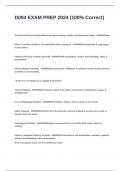D094 EXAM PREP 2024 (100% Correct)
Arnold Gesell theorized that children develop according to distinct developmental stages - ANSWERSTrue
Which 2 activities should an 18 month-old be able to perform? - ANSWERSStacking books & using fingers
to eat crackers
Maslow's Hierarchy of Needs (pyramid) - ANSWERSself-actualization, esteem, love/belonging, safety, &
physiological.
Self-actualization (Maslow) - ANSWERSpersonal growth, fulfillment, & realization needs of one's personal
potential as a human being.
"To become everything one is capable of becoming."
esteem (Maslow) - ANSWERSSelf respect, respect from others, achievement, independence, status, &
prestige needs.
Love and Belonging (Maslow) - ANSWERSFriendships, intimacy, trust, romance & love needs
Safety (Maslow) - ANSWERSProtection from the elements, financial & physical security, law & order, &
freedom from fear needs
Physiological (Maslow) - ANSWERSBiological requirements for survival like food, water, shelter, &
clothing
Maslow's expanded hierarchy of needs - ANSWERSTranscendence, self-actualization, aesthetic, cognitive,
esteem, love/belonging, safety, physiological.
(First 4 are growth needs, last 4 are deficiency needs)
, Physiological Needs are the 1st needs that must be met in Maslow's hierarchy - ANSWERSTrue
Lucas is a 4th grade student who has read almost every book in the class library. He asks his teacher if
she'll bring him some "bigger kid" books to read because he's bored with the material in the classroom.
Which need is he trying to satisfy? - ANSWERSCognitive
stages of physical development (Arnold Gesell) - ANSWERSInfancy: birth-2 years old, adding motor skills,
holding up head, rolling over, reaching for things, sitting, crawling, & walking. By 2 they're walking with
increased coordination, manipulating toys in hands, feeding themselves, making towers of cubes,
jump/running awkwardly, throwing things, & using a zipper
Early childhood: 2-6yrs old, improvements in gross & fine motor skills, running, jumping, climbing,
tumbling, & swinging. Can string beads, put puzzles together, & begin to scribble. By 4 many can print
their names, dress/undress themselves, & eat with utensils
Middle childhood: 6-10yrs old, gain weight & height, permanent teeth grow in. Participate in organized
sports as speed & coordination skills advance, continue to refine motor skills resulting in improved
handwriting & drawings. Can use fine motor skills to sew, build models, or do other crafts
Adolescence: 10-18yrs old, weight/height increases rapidly, includes puberty. Girls usually begin earlier
than boys. Increase in hormones affect behavior, might reject adult authority, & reach sexual maturity
Ren is 3yrs old. His preschool teacher is worried about him because he can't print his name yet. The
teacher's concern is justified. - ANSWERSFalse
In middle school classrooms, teachers can use the same activities for all students. - ANSWERSFalse
An 18 month old in daycare recently developed ability to roll a ball back & forth w/ an adult.
A 5yr old kindergartener recently developed ability to draw a stick figure family of himself, his parents, &
his sister.
A 9yr old 4th grader recently developed ability to shoot baskets consistently on school playground.




